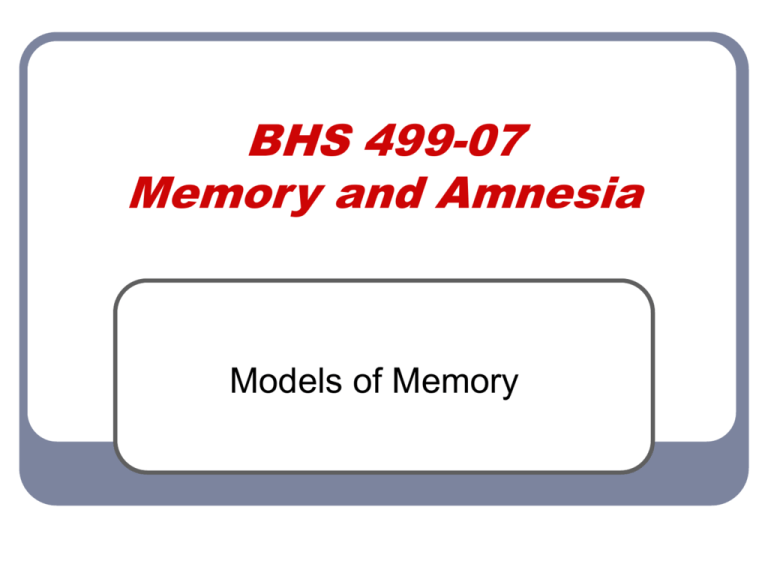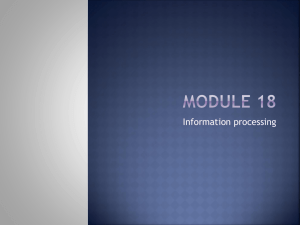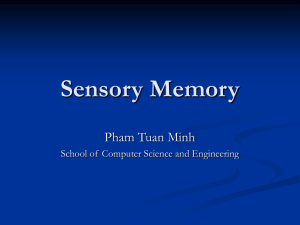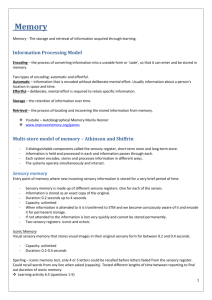Chap4
advertisement

BHS 499-07 Memory and Amnesia Models of Memory Plato’s Model Plato extended the wax tablet metaphor to refer to birds in an aviary. • Birds are located in specific places. • Search processes are needed to hunt for them. William James referred to primary and secondary memory. • New experiences linger briefly and need not be stored forever (secondary memory). The Modal (Multi-Store) Model of Memory Modal refers to sensory modality (way of receiving info from outside world). Heuristic means “rule of thumb” – this theory of stages is a way of thinking about memory not to be taken literally. This multistore (modal) model was the guiding framework for decades. Multiple Memory Systems Memory is not unitary but consists of several subcomponents (parts). Atkinson & Shifrin: Tulving’s Triarchic Theory: • Sensory store, short term, long term stores • Episodic • Semantic • Procedural Autonoetic (self) Noetic (formal knowledge) Anoetic (automatic skills) Other Classifications Declarative vs Nondeclarative • Declarative includes episodic and semantic • memory Nondeclarative includes procedural memory, classical conditioning and priming Explicit vs implicit • Explicit memory involves consciousness, implicit does not. Beyond Multi-store Models Levels of processing theory (Craik & Tulving) – it isn’t where memories are processed that matters, but how. • Shallow vs deep processing • Elaborative rehearsal vs repetitive rehearsal Short term memory was replaced by Baddeley’s model of the central executive (where rehearsal takes place). Current Issues Neurological bases for memory Impact and importance of emotion on memory Use of multiple memory sources (fuzzy trace theories) Embodied cognition – how our grounding in the world influences memory Sensory Memory Three sensory registers discussed by Radvansky and Parkin texts: • Visual sensory register (iconic memory) • Auditory sensory register (echoic memory) • Touch sensory register (haptic memory) Briefest duration -- < 5 sec Retains characteristics of the stimulus so that meaning can be interpreted Iconic Memory How many items, how long does it last? It is difficult to study the capacity of iconic memory because items fade before people can report them aloud. • Averbach found that increased presentation • time did not improve memory for dots. Sperling’s partial report procedure showed that an entire array was remembered well, but only for ~.250 seconds, ¼ sec. Increasing the duration of the stimulus increases the dots remembered up to 6, but not much after that. Sperling’s partial report procedure showed greater recall when a tone cued people to look at a specific line immediately after viewing the stimulus, but not after a delay. Anorthoscopic Perception Images in the iconic register are combined to form a single mental representation. Anorthoscopic perception (seeing more than is there) – an image is passed through a slit at 250-300 ms (quickly). • The original icon is compressed to build up the entire representation – so not an after image but a constructive process. The longer a stimulus is viewed, the closer the response is to the actual stimulus (see Actual and 2110 ms) Trans-Saccadic Memory Saccade – an eye movement (~ 30 ms). • Our eyes are constantly moving over the objects in the world. Fixation – when eyes stop on a point (typically ~ 300 ms). A trans-saccadic memory is needed to build-up a mental representation from all of the eye movements Subjects were unable to make the necessary comparisons in either of these two tasks, so there must exist a transsaccadic memory store. Change Blindness Visual memory is not always accurate. • Movies frequently contain errors of detail that • go unnoticed – continuity errors Only 33% of subjects noticed the change of an actor of the same ethnicity & gender. Top-down expectations affect what is noticed. • Students notice students not construction workers, or changes that belong in a scene. Echoic Memory Echoic memory lasts briefly to permit a mental representation to be formed. • More exists in memory than can be reported. • Retention of info is longer (~ 4 sec). Because sounds can only be heard once, info is kept available longer. Flow of speech is constructed from a series of passing sounds. Haptic Memory Less studied. Air jets were used in a whole/partial report procedure. • Duration was ~ 1.3 seconds. Short Term Memory Dispute – is short term memory qualitatively different from long-term memory? • Or is it just the part of long term memory that is currently active? Severely limited in capacity (unlike sensory registers). • Miller’s magic number of 7 +/- 2 (or 4 +/- 1). Chunking We are capable of thinking about more by forming units out of smaller pieces of information. • The number of chunks is the same as the number of units that can be remembered. Prior knowledge guides the chunking process. • Race lengths, chess games are large chunks S.F.’s digit span improved with practice as he learned to chunk digits in terms of race results. Duration of STM Without active attention, info is forgotten in ~ 30 sec (some sources say 15) • How do you tell people not to think about something so you can test it? Is forgetting due to decay or interference? • Decay -- passage of time erases trace. • Interference – new info displaces the old This task tests for interference. This task tests for delay. STM Retrieval Does retrieval involve a serial or a parallel search? • Sternberg’s paradigm of digits followed by a • • probe showed serial exhaustive search. Most people find this result surprising, showing why self-report may be flawed. An alternative explanation is parallel search with limited resources (requiring more time). Most likely both processes are involved. Serial Position Curves Position in a list of items affects likelihood of being recalled. Primacy effect – items at the beginning of a list are remembered better. • Due to encoding in long term memory via more rehearsal. Recency effect – items at the end of the list are remembered well because still active in short term memory. Modifying Serial Position Effects Placing an irrelevant item at the end of a list eliminates the recency effect. Memory for actions is different – no primacy effect because the focus is on individual actions so less rehearsal. Suffix effect – recency effect is diminished when new info is added at the end (the more the greater the effect). Memory for Order of Items The position of the item must be remembered, not the item itself. Slot-based models – info is dropped into a series of slots, read off in order. Chaining models – associative links form a chain (but items can be skipped). Perturbation model – hierarchy of chunks is disturbed. More Serial Order Models Inhibition models – retrieval starts with the most active, then inhibits it and goes to the second most active, and so on… • • Inhibition prevents things just recalled from being recalled again immediately. Repetition blindness – people fail to see the same word presented soon after it was first seen on a screen. Context-based models – order tied to context.









